Memory games activate your brain’s neuroplasticity, creating new neural pathways that bypass stroke damage. When you play these games regularly, you’re triggering synaptogenesis—forming fresh connections between neurons that support recovery. They provide multisensory stimulation while offering achievable challenges with immediate feedback, keeping you motivated through visible progress tracking. Memory exercises strengthen both damaged and undamaged brain regions, enhancing overall cognitive function. Discover how specific games and approaches can dramatically accelerate your healing journey.
The Science of Neuroplasticity in Stroke Recovery
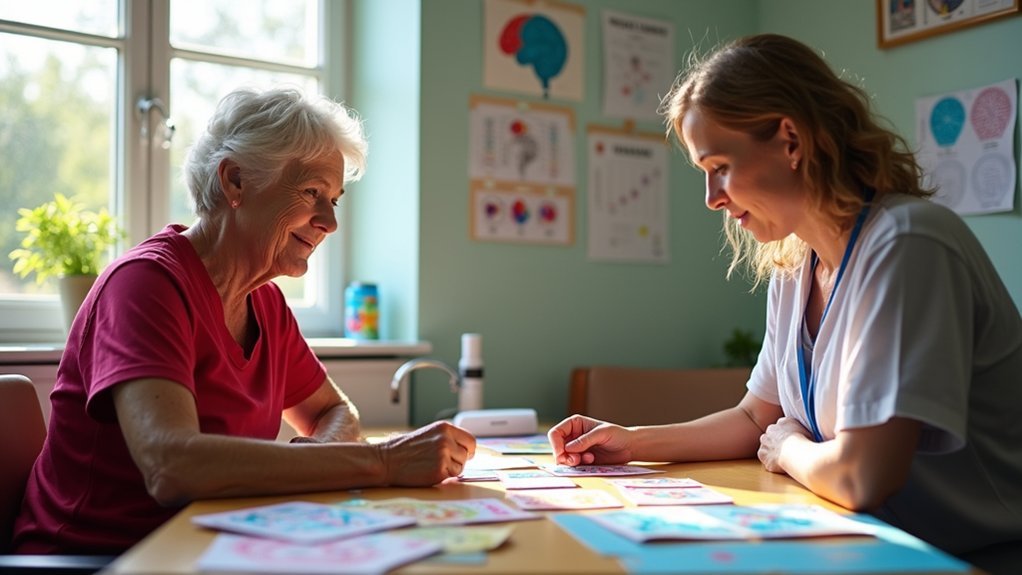
When a stroke damages brain tissue, the remarkable ability of neuroplasticity becomes a critical factor in recovery. Your brain can reorganize itself by forming new neural connections throughout life, allowing undamaged regions to compensate for injured areas.
This process isn’t just theoretical—it’s the foundation of your recovery journey. After stroke, your brain initiates spontaneous healing through local and network-wide reorganization. Noninvasive imaging techniques like PET and fMRI have been instrumental in understanding these neuroplastic mechanisms. The interaction between your injured and uninjured hemispheres redistributes functions to restore abilities.
Your brain’s remarkable reorganization after stroke isn’t just science—it’s the cornerstone of your healing process.
Research shows this recovery window is time-sensitive. Your brain’s adaptability means damaged functions can be reassigned through cortical re-projection and synaptic reconnection.
Rather than restoring original cells, your brain creates compensatory repairs by recruiting alternative pathways—a powerful mechanism that rehabilitation techniques can enhance to maximize your recovery potential.
How Memory Games Rewire the Brain After Stroke
When you play memory games after a stroke, your brain forms new neural pathways that bypass damaged areas.
These games activate multiple senses simultaneously, creating rich stimulation that accelerates the rewiring process. Both working memory and long-term memory are engaged during gameplay, strengthening cognitive connections that support recovery.
Your brain also develops compensatory mechanisms, where healthy regions take over functions previously managed by damaged areas, helping restore lost cognitive abilities.
Neural Pathway Formation
Three key mechanisms drive neural pathway formation after a stroke. When you engage in memory games, your brain activates neuroplasticity—its remarkable ability to reorganize itself by forming new neural connections. This process helps bypass damaged areas and establish alternative routes for information flow.
- Synaptogenesis occurs as you play memory games regularly, creating new connections between neurons and strengthening communication networks.
- Neurotrophic factors are released during engaging cognitive activities, supporting neuron health and promoting growth in areas affected by stroke.
- Synaptic pruning removes inefficient connections while memory challenges encourage more productive neural pathways.
The brain’s rewiring process works most effectively through repetition and increasingly challenging memory exercises. Regular participation in brain exercises supports emotional health while stimulating these neural mechanisms, creating a positive feedback loop for recovery. This targeted stimulation encourages undamaged brain regions to compensate for affected areas, establishing robust neural highways for improved cognitive function.
Multisensory Brain Stimulation
Although traditional rehabilitation focuses on single-sense exercises, multisensory brain stimulation has emerged as a powerful approach for rewiring the brain after stroke.
When you engage with memory games, you’re actually activating multiple sensory systems simultaneously—visual recognition, auditory feedback, and tactile interaction.
This multisensory approach isn’t just more engaging—it’s scientifically proven to enhance neuroplasticity. In fact, 20 out of 21 studies show positive outcomes when stroke patients receive multisensory stimulation.
The games you play provide immediate feedback while adapting to your progress, creating the perfect environment for neural recovery.
Memory games work particularly well as preparatory tools before other therapies like constraint-induced therapy.
Starting multisensory stimulation early in your recovery journey can greatly improve both cognitive function and motor skills.
Advanced technologies like virtual reality can create immersive environments that engage three or more senses, providing a richer rehabilitation experience than traditional methods.
Compensatory Mechanism Activation
Following a stroke, your brain begins an extraordinary process of compensatory mechanism activation, effectively finding new pathways to regain lost functions.
Memory games specifically target this neural reorganization by stimulating peri-infarct regions—areas adjacent to damaged tissue that possess untapped functional capacity.
When you engage with memory challenges regularly, you’re:
- Triggering axonal sprouting in the cortical and corticospinal tracts
- Strengthening cortico-cortical and subcortical pathways essential for motor relearning
- Enhancing bidirectional synaptic changes throughout neural networks
These games aren’t merely recreational—they’re therapeutic tools that leverage your brain’s natural plasticity. Pyramidal cells, which make up 70-80% of cortical neurons, play a crucial role in processing the sensorimotor inputs activated during memory game exercises.
Five Essential Memory Games for Home Rehabilitation
Choosing the right memory games for stroke recovery can greatly accelerate cognitive rehabilitation at home.
Memory Match exercises your short-term memory as you flip cards to find matching pairs, directly stimulating your hippocampus. Simon Says challenges your focus and sequential memory through mimicking actions.
Memory games like Memory Match and Simon Says target key brain functions, creating fun pathways to rebuild cognitive connections after stroke.
For language processing, crossword puzzles improve word recognition while boosting cognitive skills. Jigsaw puzzles enhance your spatial memory and cognitive dexterity as you fit pieces together. Spot It exercises visual discrimination and scanning abilities in a fast-paced format.
These games offer more than cognitive benefits—they provide social interaction, boost confidence, and reduce stress. Regular participation in these activities can significantly lower the risk of recurrence among stroke survivors by keeping the brain actively engaged.
You can adapt them with simplified rules, verbal prompts, or visual aids to match your current abilities, gradually increasing difficulty as you improve.
Personalized Gaming: Tailoring Challenges to Recovery Stages
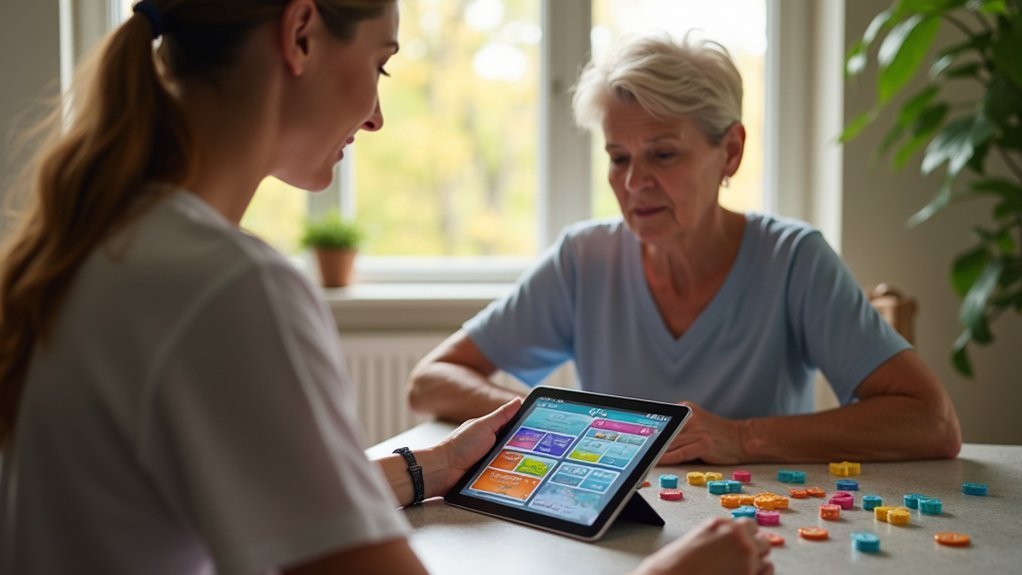
Personalizing memory games with adaptive difficulty levels is essential for your stroke recovery journey.
You’ll need different challenges as you progress from simple tasks in early stages to complex problem-solving activities later on.
Your rehabilitation exercises should grow with you, providing just enough challenge to stimulate neuroplasticity without causing frustration or disengagement.
Consider using printable resources that focus on cognitive brain games specifically designed for stroke recovery and memory enhancement.
Adaptive Difficulty Levels
When stroke patients engage with memory games that automatically adjust to their abilities, they’re more likely to remain motivated throughout their recovery journey.
These adaptive challenges prevent frustration by ensuring tasks are neither too simple nor impossible, creating an ideal learning environment that promotes neuroplasticity.
AI-driven technology now enables games to make real-time adjustments based on your performance, delivering personalized cognitive stimulation that evolves as you recover:
- Challenges increase in complexity precisely when you’re ready, maintaining the perfect balance of difficulty
- Performance tracking provides clinicians with accurate recovery data to refine your treatment plan
- Engagement remains high across rehabilitation phases, leading to increased training doses and better outcomes
Clinical studies confirm these adaptive approaches considerably reduce dropout rates while enhancing cognitive recovery outcomes.
Appropriately designed games with remappable controls allow stroke survivors to customize the interface according to their specific motor limitations, making gameplay accessible despite one-sided weakness.
Progression-Matched Challenges
Progression-matched challenges take adaptive difficulty to the next level by precisely aligning gaming experiences with each patient’s unique recovery journey.
When games match your current abilities while gently pushing boundaries, they activate neuroplasticity—your brain’s ability to reorganize and form new connections.
These personalized challenges stimulate both motor skills and cognitive functions simultaneously. You’ll experience improved adherence to rehabilitation as tasks feel meaningful and achievable rather than frustrating.
The dopamine release from accomplishing well-matched challenges reinforces neural pathways while boosting your mood.
Technology integration through motion-sensing devices and VR creates immersive environments that make repetitive therapeutic movements engaging.
Cross-lateral exercises help balance function between affected and unaffected body parts, activating alternative neural pathways essential for recovery.
This personalized approach transforms rehabilitation from obligation to opportunity. Studies show that game-based therapy utilizing multisensory stimulation significantly enhances hand-eye coordination in stroke patients.
Virtual Reality Memory Games: The New Frontier in Recovery
As technology continues to advance, virtual reality has emerged as a groundbreaking tool in stroke rehabilitation. VR memory games create immersive environments that not only engage you more deeply than traditional therapy but also enhance neuroplasticity—helping your brain form new neural connections around damaged areas.
- Personalized challenges: VR systems can be tailored to your specific recovery goals, adjusting difficulty as you progress.
- Enhanced motivation: The engaging nature of VR keeps you committed to therapy longer, potentially accelerating your recovery.
- Real-world application: Skills practiced in VR—from visuospatial awareness to executive function—translate directly to daily activities.
Your therapist can integrate these immersive puzzle games with your routine rehabilitation, creating a thorough approach that makes recovery more effective and considerably less tedious. Patients using systems like NeuRRoVR often identify with their avatars, which research shows can enhance therapeutic engagement.
Making Rehabilitation Fun: Gamification Principles That Work
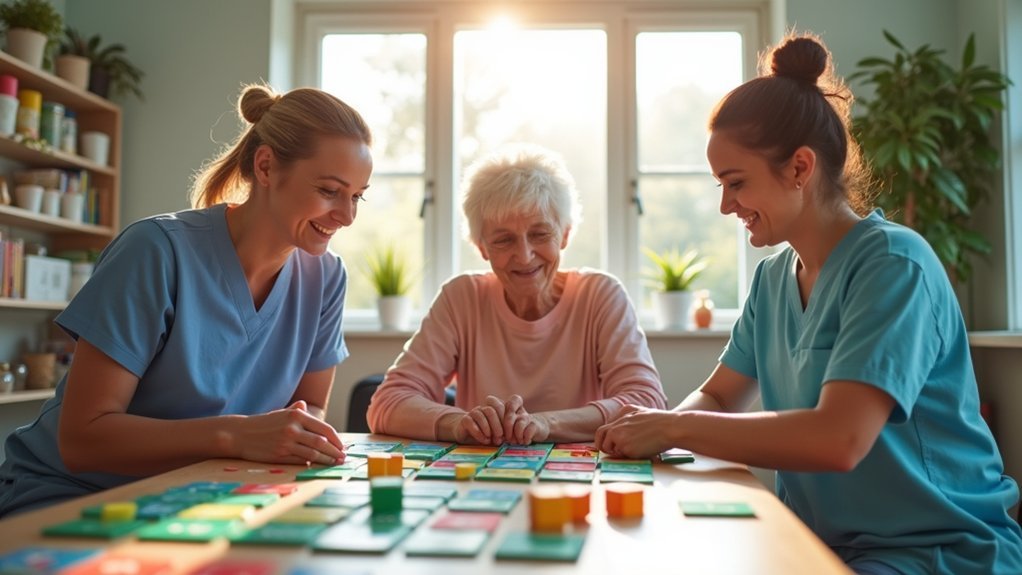
You’ll find stroke rehabilitation transforms when games add motivation through achievable challenges and reward systems that make therapy feel less like work.
Tracking your progress visually through levels, scores, or digital achievements creates tangible evidence of your recovery journey.
Many successful rehabilitation games incorporate social elements like multiplayer modes or leaderboards, allowing you to share your recovery experience with others facing similar challenges. Devices like ArmAble™ provide intensive, task-based therapy through functional gaming experiences that significantly improve upper limb function in acute stroke patients.
Motivation Through Play
Transforming tedious rehabilitation exercises into engaging activities, gamification has revolutionized stroke recovery by making therapy both effective and enjoyable. You’ll experience greater persistence in your recovery journey when rehabilitation incorporates game elements that create purpose and meaning.
- Game narratives and goals transform repetitive movements into missions that protect objects or achieve high scores.
- Immediate positive feedback through rewards and progress visuals encourages your continued effort.
- The enjoyment factor reduces your perception of pain and frustration typically associated with traditional exercises.
When you’re having fun, you’re more likely to stick with your therapy regimen. This emotional engagement isn’t just making treatment more pleasant—it’s activating neuroplastic mechanisms that facilitate faster recovery through consistent, motivated practice. Research shows that motor mental imagery techniques combined with gamification can improve the rehabilitation experience without compromising effectiveness, particularly for patients with limited physical mobility.
Progress-Tracking Success
When rehabilitation incorporates visible progress tracking, your motivation soars and recovery accelerates. Gamified therapy systems leverage this psychological principle by showing you real-time improvements in your performance, making your rehabilitation journey measurable and rewarding.
Studies involving over 6,400 patients confirm that tracking progress through game-based metrics increases your engagement and adherence to therapy routines. You’ll experience both immediate and short-term functional improvements that traditional rehabilitation mightn’t deliver as effectively.
Technologies like ArmAble and mobile-based games make this tracking seamless, turning mundane exercises into enjoyable challenges with clear milestones. The intensity of practice, which research confirms is crucial for improving recovery outcomes post-stroke, becomes more achievable when incorporated into engaging, game-based interventions.
The combination of positive reinforcement when you succeed and helpful feedback when you struggle creates a prime environment for neuroplasticity. This approach doesn’t just improve motor skills—it enhances your emotional and social well-being throughout recovery.
Social Recovery Elements
Beyond individual achievements, gamification truly shines when it connects stroke survivors with others during rehabilitation.
Memory games create opportunities for social interaction that’s essential to your recovery journey. You’ll find that engaging with others through gamified therapy offers emotional support while making exercises more enjoyable.
When you participate in social gaming experiences during recovery, you’ll benefit from:
- Multiplayer challenges that foster healthy competition and accountability with fellow survivors
- Group therapy sessions where shared progress creates motivation and reduces feelings of isolation
- Family involvement opportunities that strengthen your support network and improve adherence
These social elements transform rehabilitation from a solitary struggle into a community effort. Research shows that iPad-based applications for rehabilitation can facilitate impairment-based individualized programs that accommodate each patient’s unique recovery needs.
The emotional benefits of this connection often prove just as significant as the physical improvements, creating a holistic approach to recovery.
Measuring Progress: Tracking Cognitive Improvements Through Play
As stroke recovery progresses, measuring cognitive improvements becomes essential for both patients and healthcare providers. Tools like the Montreal Cognitive Assessment (MoCA) offer standardized ways to track your global cognitive functioning, while domain-specific tests measure memory, attention, and executive function gains.
Accurate cognitive assessments provide crucial benchmarks for measuring your post-stroke recovery journey.
You’ll notice your progress through quantifiable metrics in memory games—improved reaction times, fewer errors, and ability to handle increasing complexity. These metrics complement clinical assessments, providing immediate feedback on your cognitive gains.
Healthcare teams use repeated assessments during rehabilitation to measure changes over time, often combining these with brain imaging data. Early screening is particularly important since approximately one in three individuals experience cognitive issues post-stroke. DWI measures of brain connectivity can even predict cognitive recovery up to a year post-stroke.
This thorough tracking approach guarantees your rehabilitation remains targeted and effective as you continue recovering.
Mobile Gaming Solutions for Anywhere, Anytime Recovery
Mobile gaming has revolutionized stroke rehabilitation by allowing recovery to happen virtually anywhere. You’ll find these accessible tools complement traditional therapies while offering the flexibility to practice exercises whether you’re at home or traveling.
Unlike conventional rehabilitation methods, mobile games provide:
- Cost-effective alternatives that track your progress in real-time
- Engaging experiences that keep you motivated through gamification
- Personalized approaches that develop both cognitive and fine motor skills
The portability of mobile devices means you’re no longer limited to clinical settings for your recovery work. This accessibility enables earlier intervention and more consistent practice. It’s important to remember that these activities should be used to complement professional care, not replace it.
As technology advances, the integration of motion-based games and virtual reality elements continues to enhance the effectiveness of mobile rehabilitation solutions for stroke patients.
The Social Benefits of Multiplayer Memory Games for Stroke Survivors
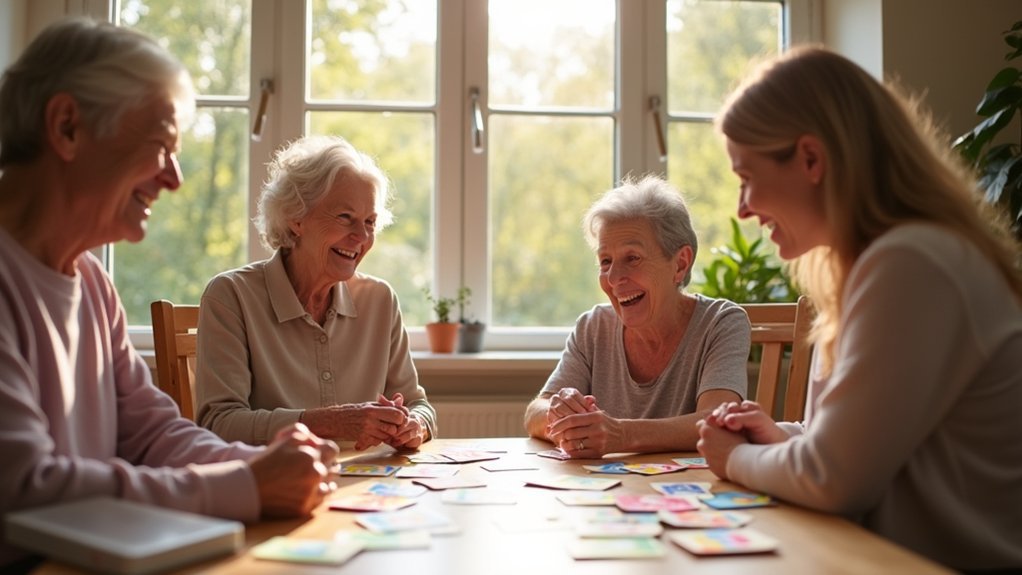
While recovering from a stroke often feels isolating, multiplayer memory games create valuable social connections that enhance the rehabilitation process.
These games build communities where you’ll connect with others sharing similar experiences, forming supportive networks that boost your emotional wellbeing.
The social aspects of multiplayer games deliver powerful psychological benefits—reducing stress, anxiety, and depression symptoms while improving your overall mood.
You’ll also experience enhanced cognitive recovery as social engagement makes memory exercises more memorable and effective.
With today’s accessible technology, you can join virtual multiplayer sessions regardless of physical limitations.
The competitive and cooperative elements keep you consistently motivated, helping you track progress and achieve rehabilitation goals. Setting clear, measurable goals related to your social gaming achievements helps healthcare providers track your rehabilitation progress more effectively.
These social gaming experiences transform solitary recovery into an engaging journey shared with others who understand your challenges.
Integrating Memory Games With Traditional Therapy Methods
Memory games represent a powerful complement to traditional stroke rehabilitation when strategically integrated into your therapy plan. By combining these cognitive exercises with physical and occupational therapy, you’ll activate multiple recovery pathways simultaneously, creating a synergistic effect that enhances neuroplasticity.
- Therapists can customize memory games to target your specific cognitive deficits while complementing your personalized rehabilitation goals.
- Digital platforms provide real-time progress tracking, allowing therapists to monitor your improvement and adjust difficulty levels accordingly.
- Family involvement in administering these games increases consistency and supports your recovery between formal therapy sessions.
This integrated approach reduces dropout rates and maximizes your rehabilitation dose-response relationship, ultimately leading to improved activities of daily living and greater independence during your recovery journey. Given that memory deficits affect approximately 40% of survivors after stroke, these games are particularly valuable for addressing a common and significant rehabilitation need.
Success Stories: How Memory Games Changed Recovery Journeys
Real-life success stories powerfully illustrate how memory games transform stroke recovery journeys.
You’ll find inspiration in patients who’ve regained abilities through personalized video games and virtual reality experiences tailored to their specific needs. Many success stories feature combined approaches—using card games alongside puzzles to create engaging recovery plans.
Gamification has revolutionized patient motivation, with devices like FitMi making daily physical therapy exercises something to look forward to rather than dread. Consistent engagement with these interactive games has proven particularly effective for rebuilding neural pathways damaged during stroke events.
Turning therapy into play transforms recovery from obligation to opportunity, keeping patients engaged and hopeful.
Activity trackers help you monitor progress consistently, reinforcing your commitment to recovery.
Perhaps most inspiring are accounts of patients who, despite initial severe paralysis, achieved remarkable outcomes through persistent practice with innovative memory games.
These stories confirm that with the right cognitive tools, recovery potential expands greatly.
Frequently Asked Questions
How Soon After a Stroke Can Memory Games Be Started?
You can start memory games after the acute phase of stroke recovery, typically a few weeks post-stroke. They’re most effective between 3 months and 1 year when your brain shows significant potential for cognitive improvement.
Are Memory Games Effective for All Types of Stroke Damage?
Memory games aren’t equally effective for all stroke damage types. You’ll see better results with cognitive versus motor damage, and effectiveness varies between ischemic and hemorrhagic strokes. Tailoring games to your specific needs improves outcomes.
Can Memory Games Prevent Future Strokes?
Memory games alone can’t prevent future strokes, but they’re part of a brain-healthy lifestyle. You’ll benefit from improved cognitive function, but you should combine them with medical care and risk factor management.
How Long Should Daily Memory Game Sessions Last?
Aim for 15-30 minutes daily for your memory games, but always listen to your body. You’ll want to stay engaged without feeling fatigued. Take breaks if needed and adjust session length to your comfort level.
Do Insurance Companies Cover Digital Memory Game Rehabilitation Tools?
Insurance coverage for digital memory games varies widely. You’ll find some insurers now reimburse these tools, but many don’t. Check your specific policy and ask your provider about rehabilitation technology coverage options.
In Summary
You’ve just discovered a powerful tool in your stroke recovery arsenal. Memory games don’t just pass the time—they actively rebuild neural pathways, strengthen cognitive abilities, and boost your confidence. Whether you’re using simple card games or advanced VR technology, consistent practice delivers real results. As you continue your recovery journey, remember that each memory challenge you tackle is helping rewire your brain for success.

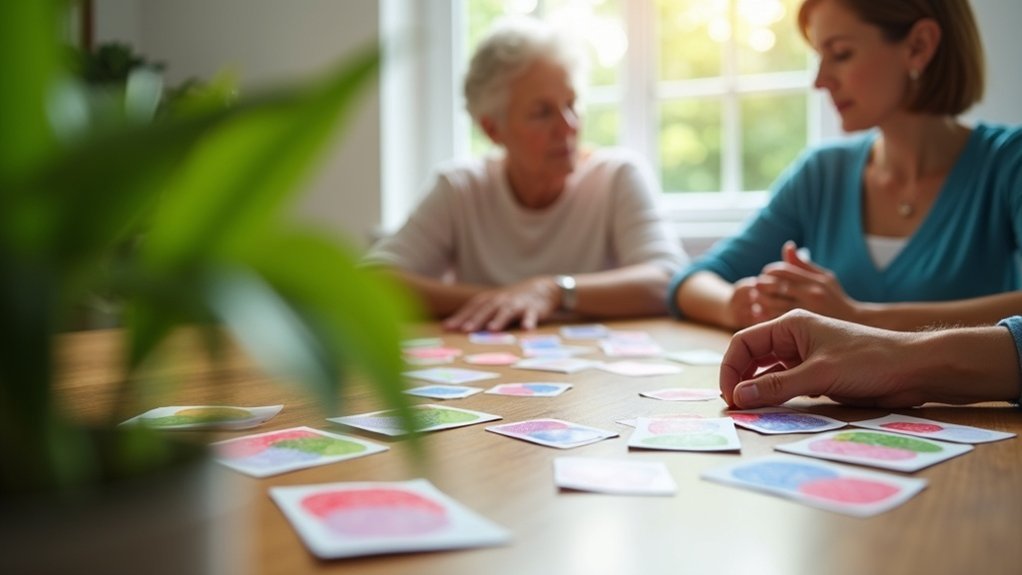



Leave a Reply